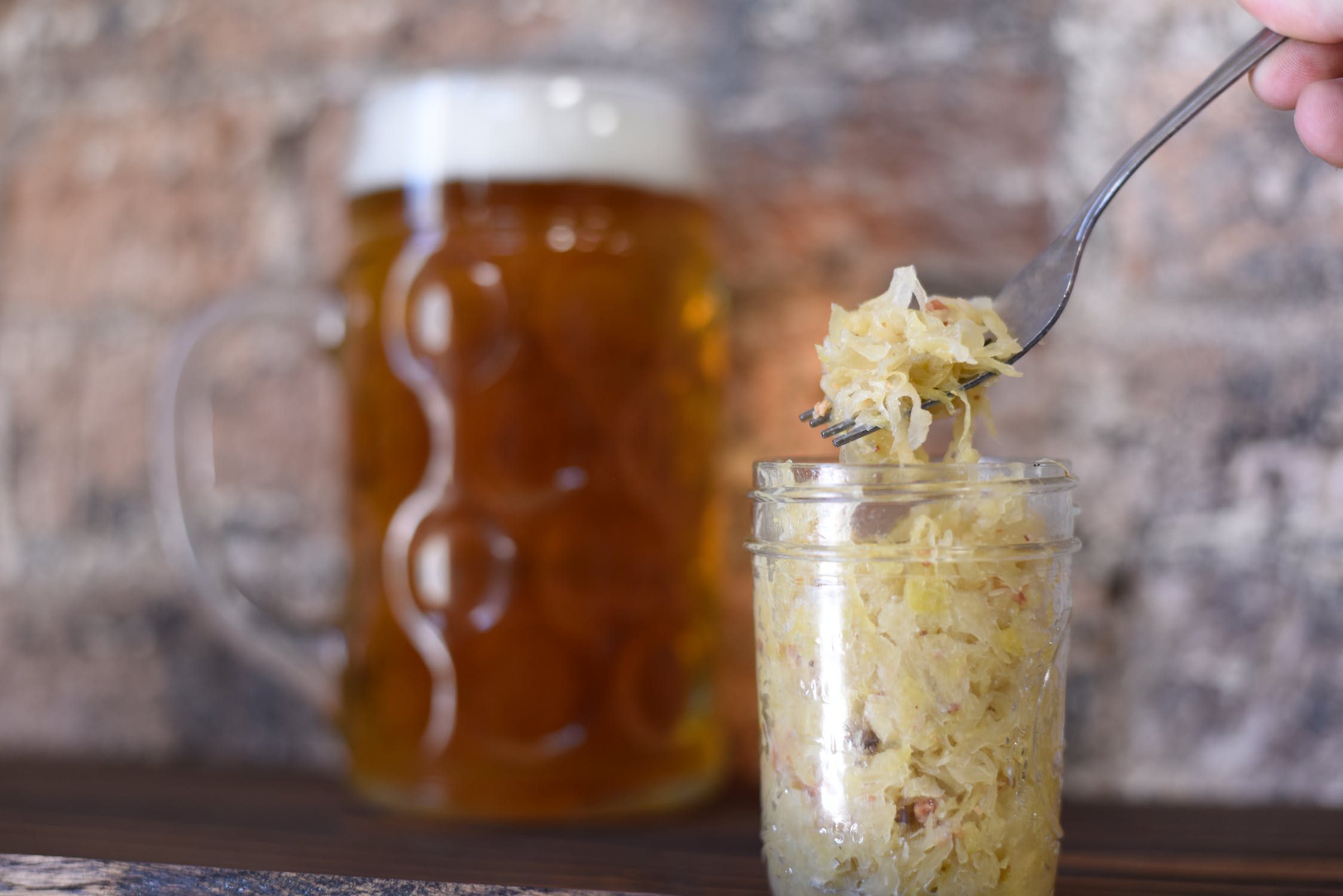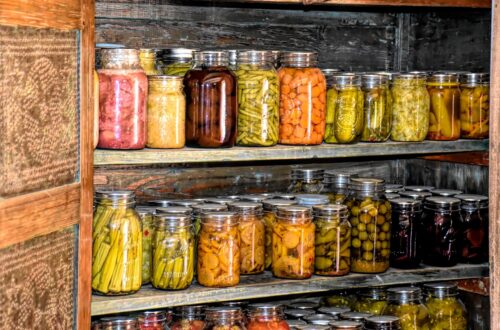Make your own sauerkraut in a crock or Mason jar with this homemade sauerkraut recipe!
Lacto-fermentation may sound complicated, but it’s an easy process that doesn’t require any special canning equipment or cooking skills. Using the naturally occurring, “good” bacteria in the air, lacto-fermentation creates a tangy and briny ferment that’s delicious and packed with probiotics. Traditional sauerkraut recipes use lacto-fermentation, but kimchi, deli pickles and other fermented foods also use this process!
In this guide, we’ll walk you through the steps you need to take to make your own lacto-fermented sauerkraut. Once your sauerkraut is finished fermenting, use it top off pork chops, hot dogs or eat it as a snack. It’s up to you!
Affiliate disclosure: As an Amazon Associate, I may earn commissions from qualifying purchases.
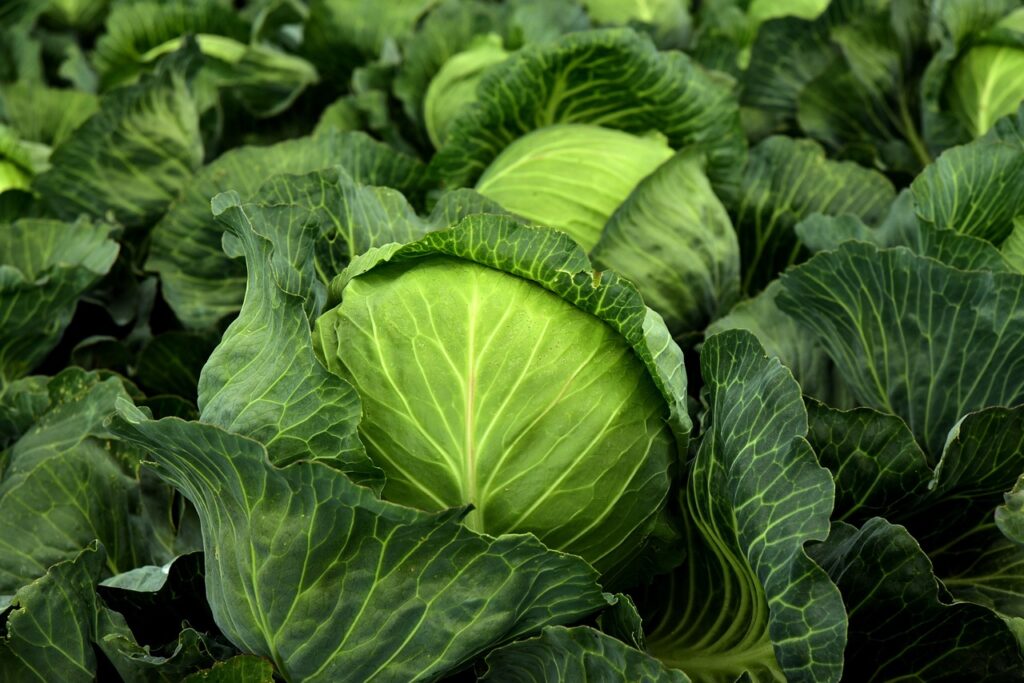
Why Make Your Own Sauerkraut?
Because it’s delicious! On top of that, making sauerkraut at home has other benefits, including:
- It prevents garden and kitchen waste. If you’re overrun with homegrown cabbages, lacto-fermentation will keep your crops from going to waste. And don’t forget, you can also ferment other garden vegetables like beets, daikon radishes and carrots!
- It’s fun. When you make sauerkraut, you have to bash and smash cabbages. It’s a pretty physical process and young kids usually love this part!
- You get a higher quality, probiotic-rich product. If you purchase sauerkraut at the grocery store and it isn’t kept in the refrigerated section, that sauerkraut has been processed with heat and it doesn’t contain probiotics. However, fresh sauerkraut that isn’t preserved with canning is packed with lots of “good guy” probiotics!
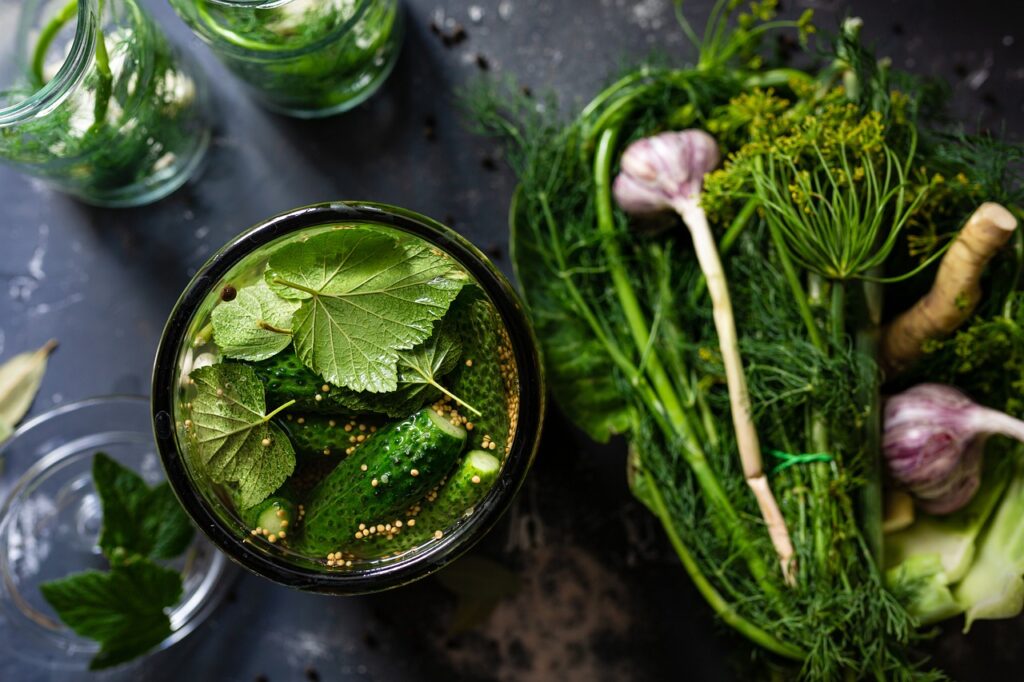
Lacto Fermentation Supplies
Technically, you don’t need any special equipment to lacto-ferment foods; however, these simple supplies can make your first fermenting experiments even easier!
- A lacto-fermentation crock, large fermenting jar or sauerkraut fermentation kit.
Large Mason jars can be used for fermentation, but using a dedicated sauerkraut crock with an airlock is even better. Airlocks allow gasses to escape during the fermentation process, but they also keep out air, which can create mold.
- Sea salt or Himalayan salt.
Avoid Kosher or iodized salt when lacto fermenting as these products may contain additives that can affect the flavor and quality of fermented goods.
- Fermentation weights.
Cabbage and other foods need to stay submerged under the salty brine during the fermentation process to prevent sauerkraut mold. If you don’t want to invest in fermentation weights, you can also fill a smaller Mason jar with water or use a cleaned stone as a budget-friendly weight for fermenting!
- Sauerkraut pounder.
In traditional sauerkraut recipes, the sauerkraut brine is produced by pressing water out of cabbage leaves with a sauerkraut pounder. Pounders can be made of wood or metal or you can use any other heavy, food-safe item… like a French rolling pin!
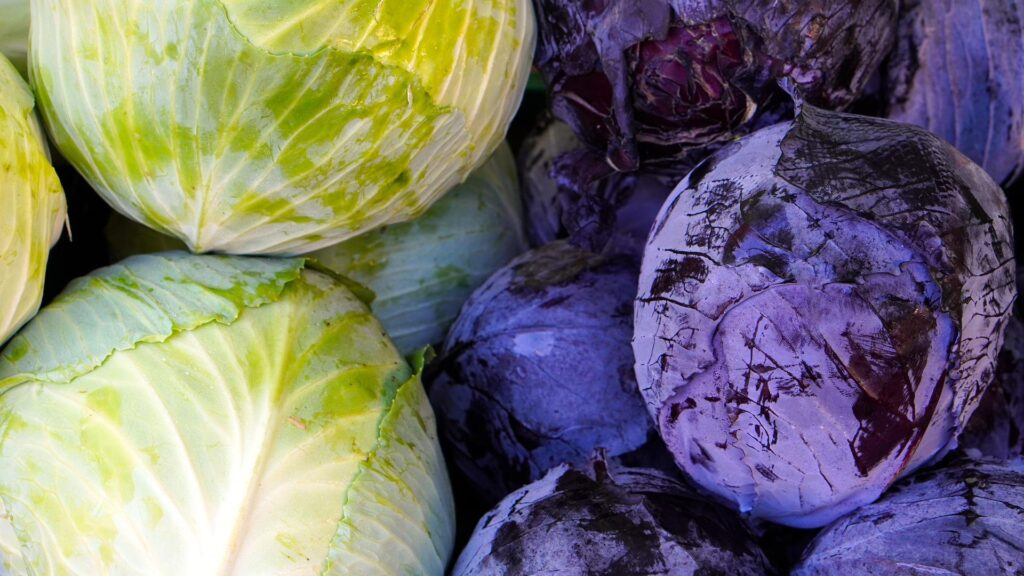
Traditional German Sauerkraut Recipe
I grew up in Pennsylvania Dutch country and THIS was the sauerkraut on everyone’s plate. Salty, tangy and flavorful, German sauerkraut is the perfect complement to bratwurst, pork chops and other rich and savory meals. (Hint: If you love sauerkraut AND spicy heat, you may also want to explore my spicy jalapeno sauerkraut recipe!)
What you’ll need:
- 1 head of red or green cabbage
- 1 tablespoon of Himalayan or sea salt
- 1 tablespoon of caraway seeds (optional)
- 1-gallon canning jar or fermentation crock
- Sauerkraut pounder (or another food safe, sturdy implement!)
- Canning weights (or another food safe weight)
- Large mixing bowl
- Cutting board
- Knife
- Metal sheet pan
The process:
1. Slice your cabbage.
Wash the cabbage and remove the outermost leaf. (Put that cabbage leaf to the side… we’ll need it later!) Cut the cabbage head into quarters, remove the core and thinly slice the head into uniform, 1/4″ wide ribbons.
2. Add salt.
Place the cabbage into a large bowl and sprinkle on 1 tablespoon of salt and the caraway seeds (if you’re using them). Thoroughly mix the salt into the cabbage and then wait about 15 to 20 minutes. During this time, the salt will draw water out of the cabbage and make it more pliable.
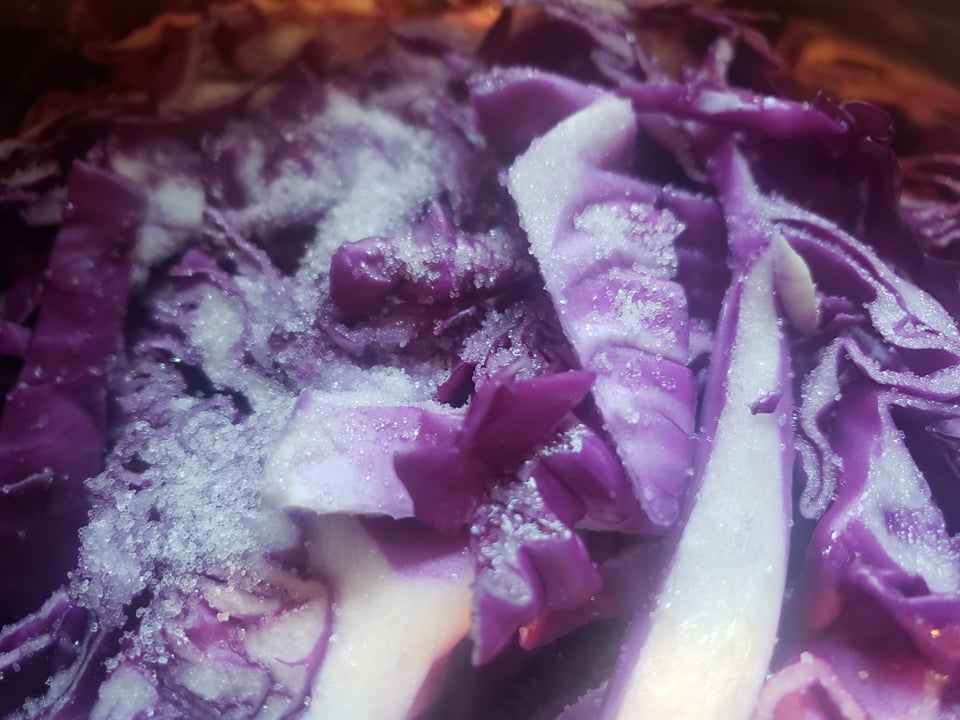
3. Mash, bash and smash that cabbage!
Using your hands or a sauerkraut pounder, crush, pound and squeeze your shredded cabbage for 8 to 10 minutes. After you’re done, your cabbage should be nice and pliant and it should have released a lot of liquid. Conserve the liquid, as this is your sauerkraut brine!
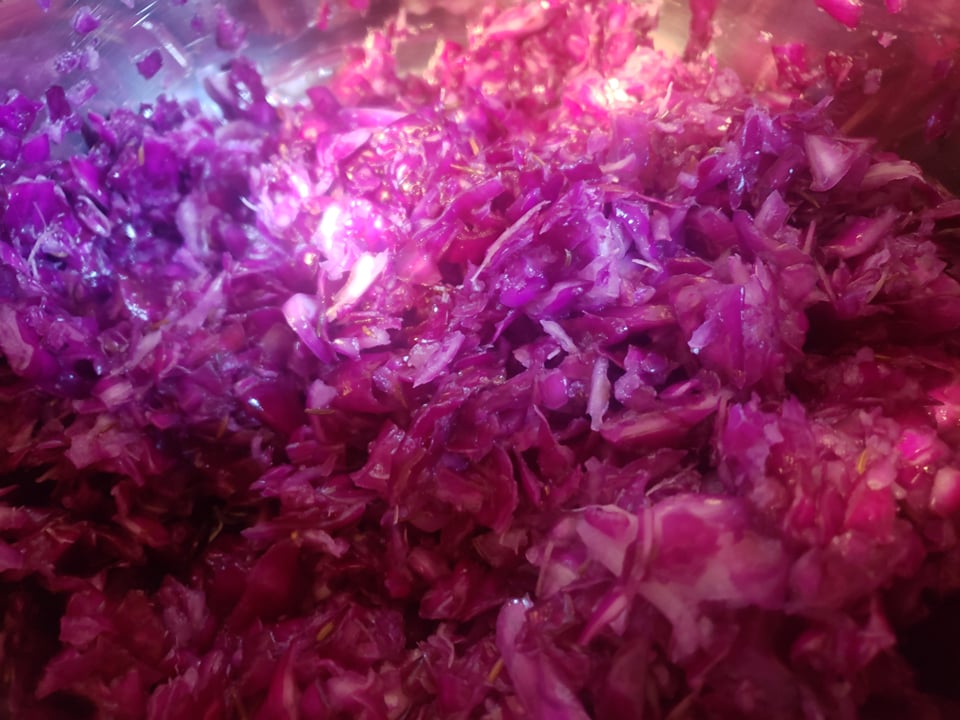
4. Pack your jar.
Pack the sauerkraut into your fermentation jar, taking the time to really press the cabbage down to remove any air bubbles. Then, pour in the sauerkraut brine.
Ideally, your cabbage should be fully submerged under the brine, which will prevent issues like mold. However, if you don’t have enough brine, you can make additional brine by mixing 4 cups of non-chlorinated water with 1 tablespoon of salt.
Remember that cabbage leaf we saved earlier? Well bring the puppy back out and layer it on top of your shredded cabbage. This leaf will keep the smaller pieces of cabbage from floating up above the brine’s surface!
Finally, place your canning weights on top of the cabbage leaf, making sure that all the pieces of cabbage are fully submerged beneath the brine.
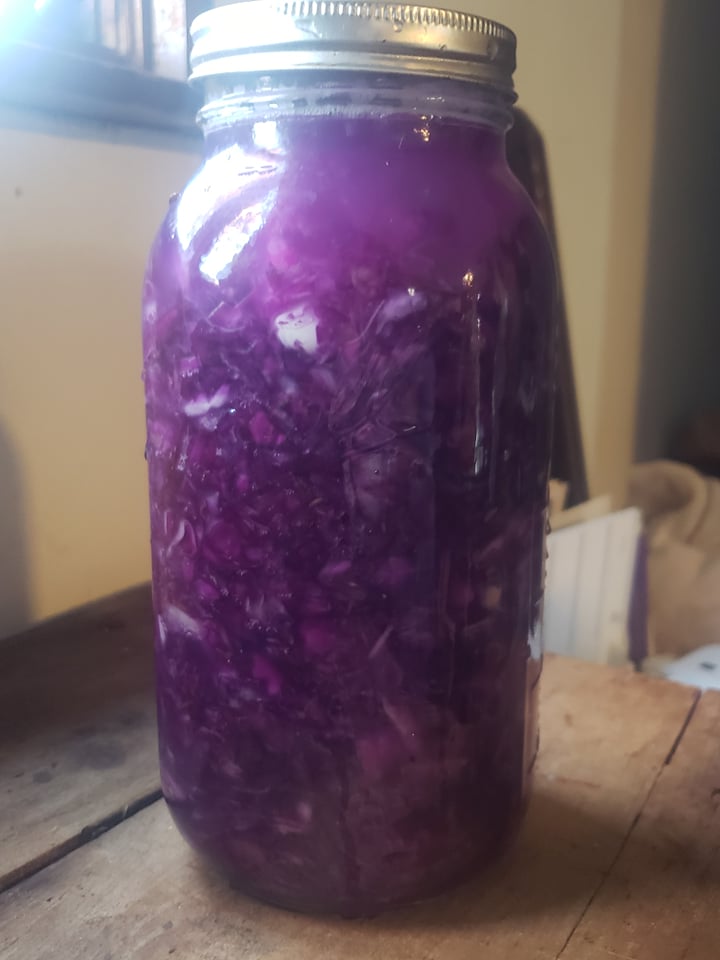
5. Ferment!
If you’re using a jar, loosely screw on your jar lid or cover the jar with cheesecloth or a clean kitchen towel secured with a rubber band. Never fully tighten the lids on fermentation crocks as gasses build up during fermentation and can cause a messy explosion!
Once you’ve covered up your ferment, place the fermentation jar in a warm, dark space (under a kitchen cabinet is ideal) and allow it to ferment for 7 to 14 days. To keep everything tidy, place your jar on top of a plate or tray in case any liquid bubbles out.
After a week, taste the fermented cabbage. If it is as sour as you like, move the jar into your fridge to slow down the fermentation process. On the other hand, if you prefer a tangier ‘kraut, ferment the cabbage for another week.

How Long Does Sauerkraut Last?
Fermented sauerkraut should be stored in your fridge, where it will stay fresh for about 4 to 6 months. If you’d like to keep your sauerkraut even longer, you can process it in jars with water bath canning; however, this process will kill off the probiotics in your ferment. If you made sauerkraut for its gut healthy benefits, you will likely want to avoid canning.
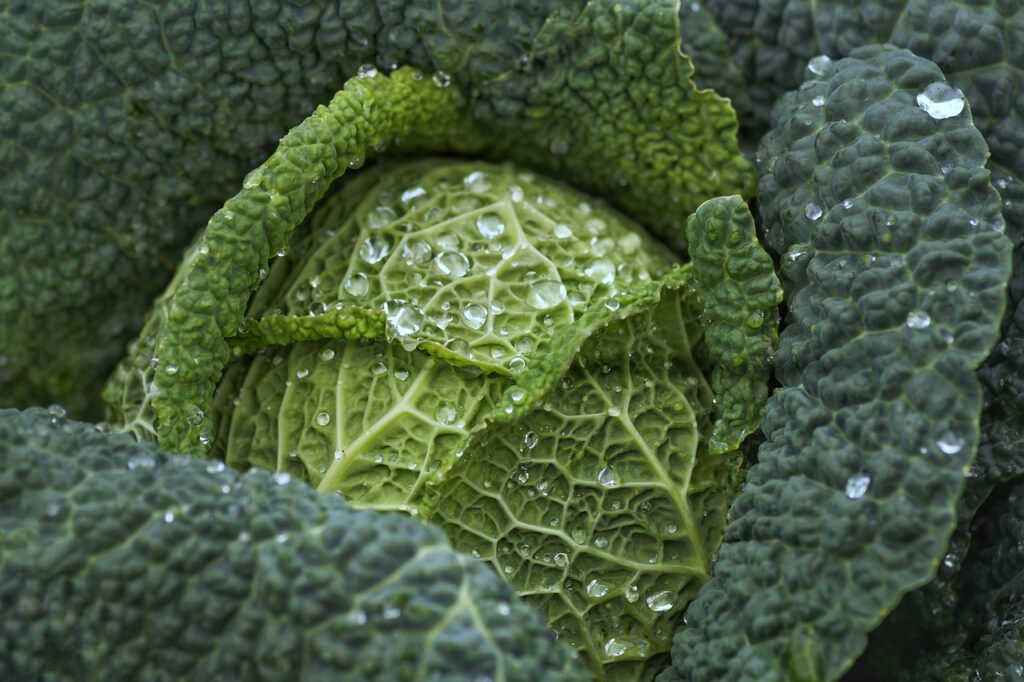
Best Cabbage for Sauerkraut:
Looking for cabbage seeds for sauerkraut recipes? Below are some of the best cabbage varieties for sauerkraut making!
- Golden Acre. A classic green heading cabbage, ‘Golden Acre’ is a versatile crop that can be eaten fresh, cooked or fermented. It’s also an early producer and yields compact cabbage heads that measure about 6 to 7″ wide.
- Red Acre. The purple version of ‘Golden Acre,’ ‘Red Acre’ is every bit as tasty as its green cousin, but it has an even more impressive color! You can even use ‘Red Acre’ cabbages to make a homemade natural dye.
- Danish Ballhead. A classic cabbage variety for sauerkraut, ‘Danish Ballhead’ cabbages have a mild flavor and perfectly, crisp leaves. These cabbages are also cold hardy and you can grow them well into winter.
- Late Flat Dutch. A long lasting, storage cabbage that’s ideal for root cellars, ‘Late Flat Dutch’ also makes a flavorful and crunchy ‘kraut. This late maturing cabbage type produces massive heads that can weight up to 15 pounds!
- Brunswick. First introduced in the 1920’s, ‘Brunswick’ is an heirloom cabbage that’s becoming increasingly hard to find. But this tasty cabbage is worth looking for and it boasts large, 6 to 9 pound heads and impressive flavor!

Frequently Asked Questions About Pennsylvania Dutch Sauerkraut
Is table salt OK for sauerkraut?
Table salt is not recommended for sauerkraut making as it often contains additives that may affect the fermentation process. Instead, look for Himalayan or sea salt, which are the preferred salt varieties for lacto-fermentation.
What can I add to sauerkraut for flavor?
Sauerkraut is plenty tasty on its own, but if you want to “spice” up your ‘kraut, try out other add-ins like carrots, apples, caraway seeds, juniper berries, thyme or red chili flakes.
Will too much salt ruin sauerkraut?
Yes, too much salt can slow down the fermentation process, while too little salt can produce a mushy and flavorless sauerkraut. Using the right ratio of salt to cabbage is imperative for tasty ‘kraut!
